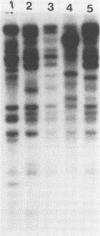Abstract
Genomic DNAs prepared from 168 isolates of Escherichia coli O157:H7 were analyzed for restriction fragment length polymorphisms on Southern blots probed with bacteriophage lambda DNA. The isolates analyzed included strains from a recent large multistate outbreak of E. coli O157:H7 infection associated with consumption of poorly cooked beef in restaurants, a day-care center cluster, and temporally and geographically unrelated isolates. E. coli O157:H7 isolates recovered from the incriminated meat and from 61 (96.8%) of 63 patients from Washington and Nevada possessed identical lambda restriction fragment length patterns. The lambda restriction fragment length polymorphisms observed in 11 (91.7%) of 12 day-care center patients were identical, but they differed from that of the strain associated with the multistate outbreak. E. coli O157:H7 from 42 patients temporally or geographically unrelated to either cluster of infection possessed unique and different lambda restriction fragment length patterns, except for paired isolates from three separate clusters of infection. These data demonstrate that the hybridization of DNA digests of E. coli O157:H7 with radiolabelled bacteriophage lambda DNA can be a useful, stable, and discriminatory epidemiologic tool for analyzing the linkage between strains of E. coli O157:H7.
Full text
PDF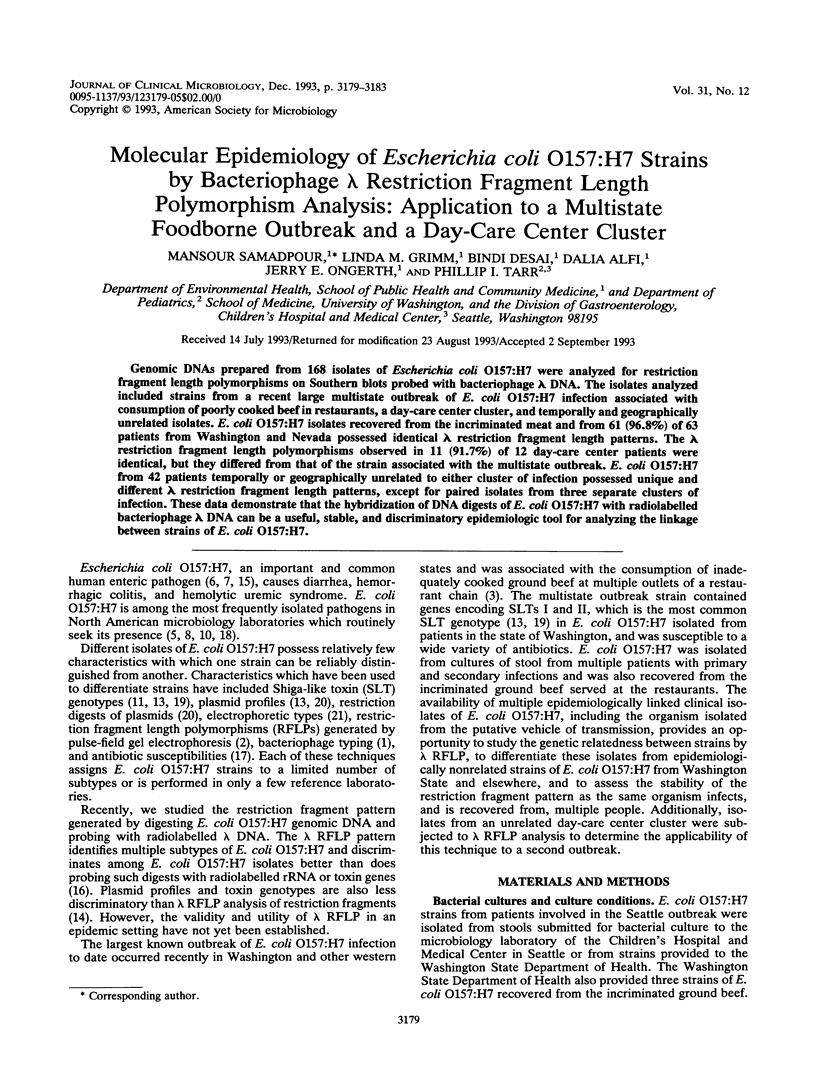
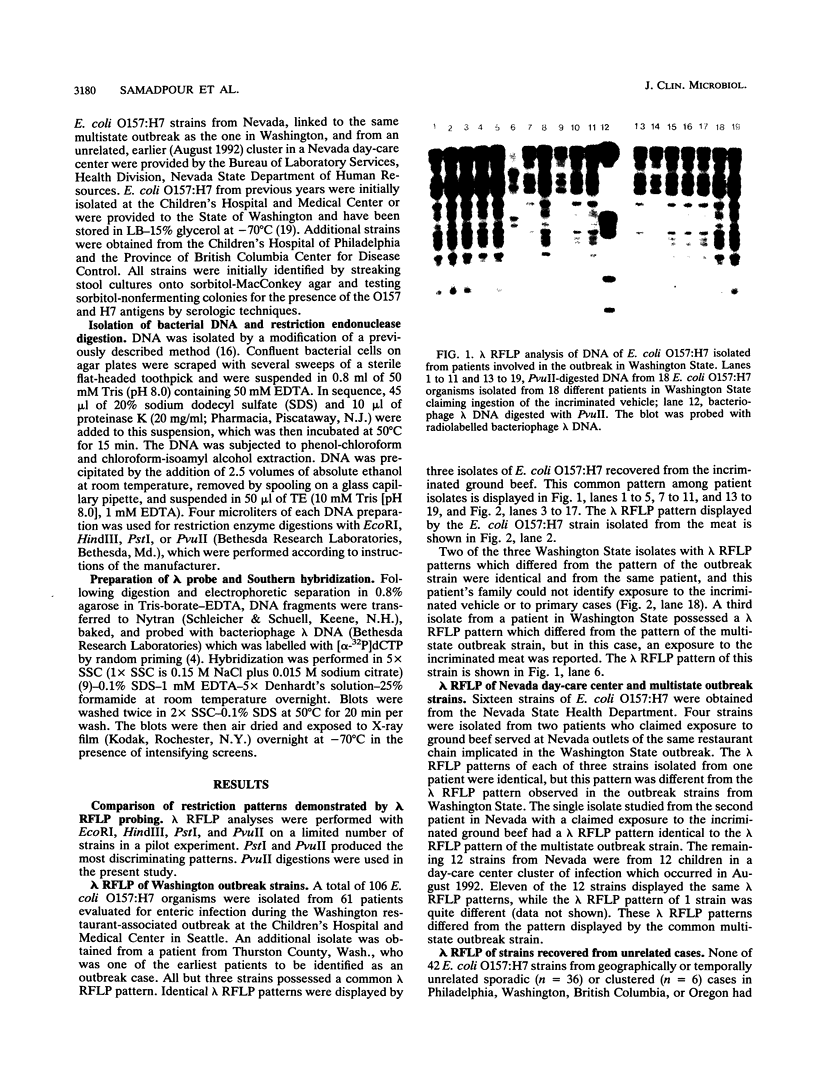
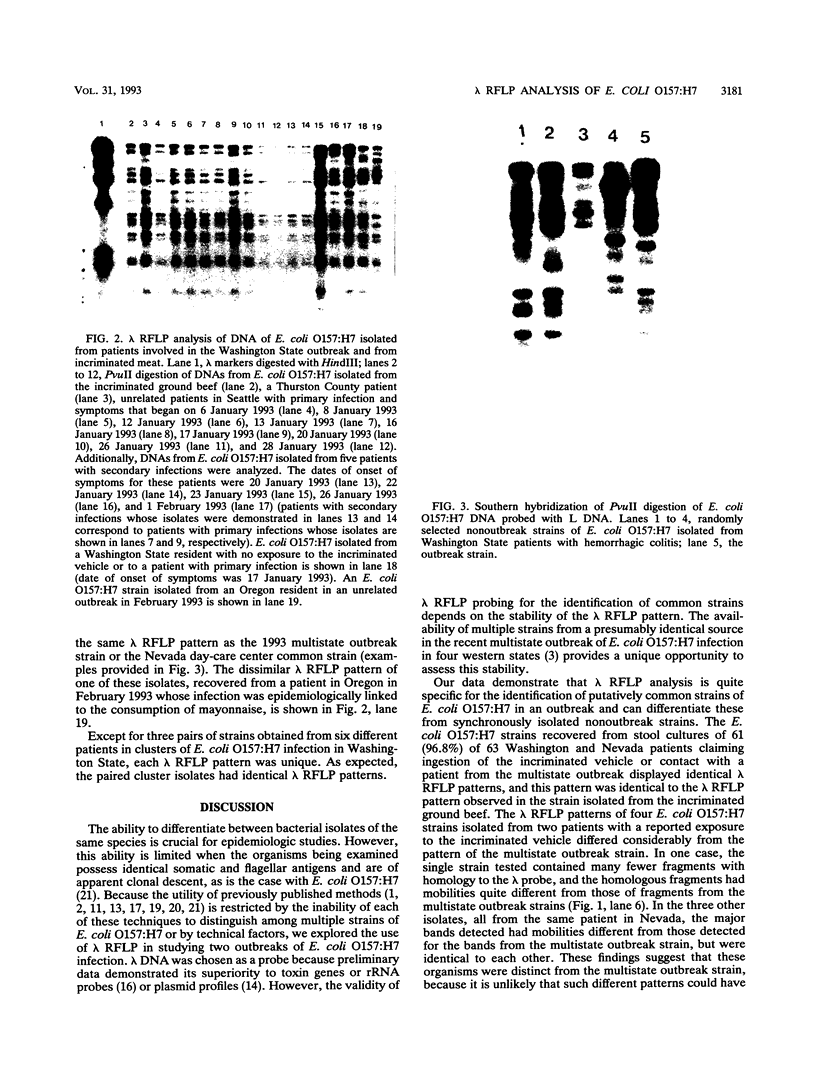
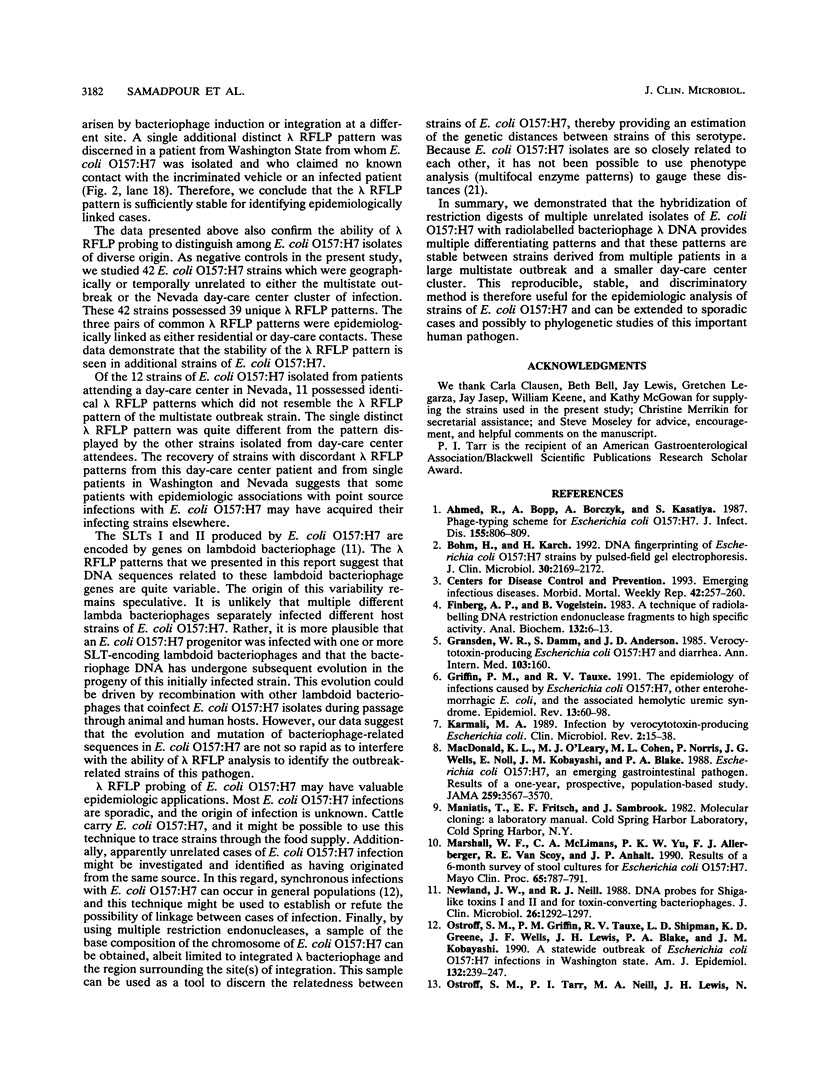
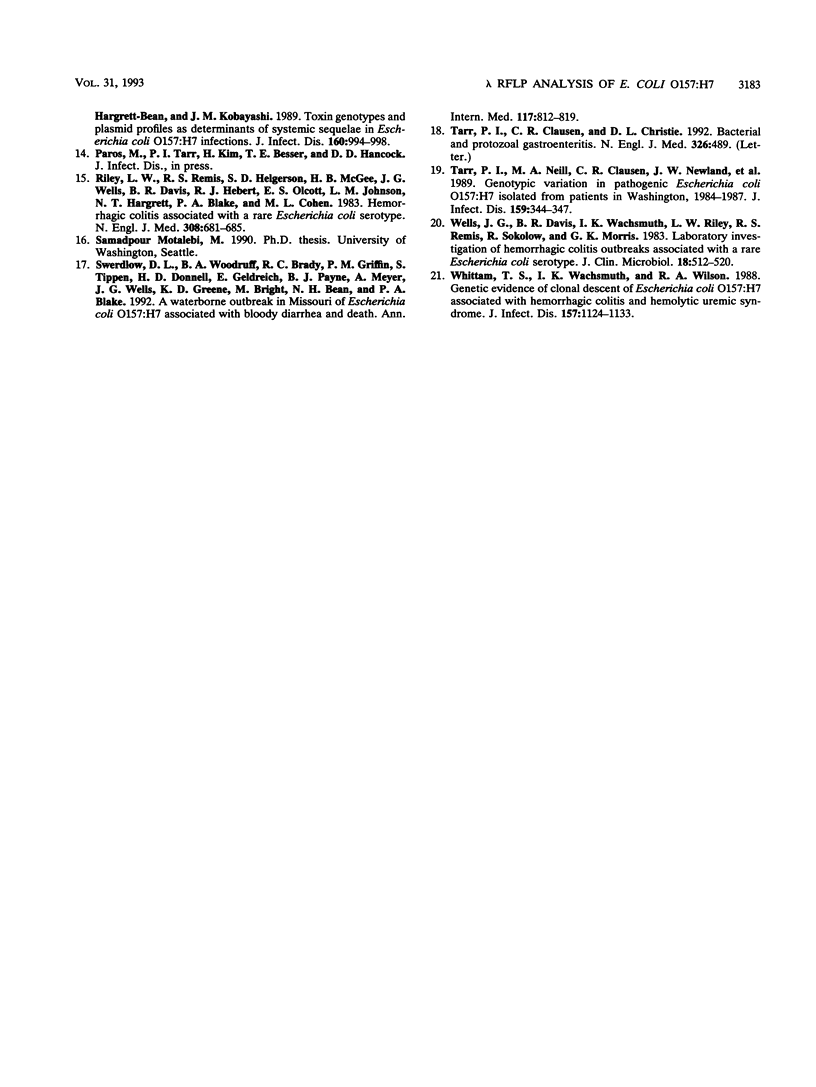
Images in this article
Selected References
These references are in PubMed. This may not be the complete list of references from this article.
- Ahmed R., Bopp C., Borczyk A., Kasatiya S. Phage-typing scheme for Escherichia coli O157:H7. J Infect Dis. 1987 Apr;155(4):806–809. doi: 10.1093/infdis/155.4.806. [DOI] [PubMed] [Google Scholar]
- Böhm H., Karch H. DNA fingerprinting of Escherichia coli O157:H7 strains by pulsed-field gel electrophoresis. J Clin Microbiol. 1992 Aug;30(8):2169–2172. doi: 10.1128/jcm.30.8.2169-2172.1992. [DOI] [PMC free article] [PubMed] [Google Scholar]
- Feinberg A. P., Vogelstein B. A technique for radiolabeling DNA restriction endonuclease fragments to high specific activity. Anal Biochem. 1983 Jul 1;132(1):6–13. doi: 10.1016/0003-2697(83)90418-9. [DOI] [PubMed] [Google Scholar]
- Gransden W. R., Damm S., Anderson J. D. Verocytotoxin-producing Escherichia coli O157:H7 and diarrhea. Ann Intern Med. 1985 Jul;103(1):160–160. doi: 10.7326/0003-4819-103-1-160. [DOI] [PubMed] [Google Scholar]
- Griffin P. M., Tauxe R. V. The epidemiology of infections caused by Escherichia coli O157:H7, other enterohemorrhagic E. coli, and the associated hemolytic uremic syndrome. Epidemiol Rev. 1991;13:60–98. doi: 10.1093/oxfordjournals.epirev.a036079. [DOI] [PubMed] [Google Scholar]
- Karmali M. A. Infection by verocytotoxin-producing Escherichia coli. Clin Microbiol Rev. 1989 Jan;2(1):15–38. doi: 10.1128/cmr.2.1.15. [DOI] [PMC free article] [PubMed] [Google Scholar]
- MacDonald K. L., O'Leary M. J., Cohen M. L., Norris P., Wells J. G., Noll E., Kobayashi J. M., Blake P. A. Escherichia coli O157:H7, an emerging gastrointestinal pathogen. Results of a one-year, prospective, population-based study. JAMA. 1988 Jun 24;259(24):3567–3570. [PubMed] [Google Scholar]
- Marshall W. F., McLimans C. A., Yu P. K., Allerberger F. J., Van Scoy R. E., Anhalt J. P. Results of a 6-month survey of stool cultures for Escherichia coli O157:H7. Mayo Clin Proc. 1990 Jun;65(6):787–792. doi: 10.1016/s0025-6196(12)62567-1. [DOI] [PubMed] [Google Scholar]
- Newland J. W., Neill R. J. DNA probes for Shiga-like toxins I and II and for toxin-converting bacteriophages. J Clin Microbiol. 1988 Jul;26(7):1292–1297. doi: 10.1128/jcm.26.7.1292-1297.1988. [DOI] [PMC free article] [PubMed] [Google Scholar]
- Ostroff S. M., Griffin P. M., Tauxe R. V., Shipman L. D., Greene K. D., Wells J. G., Lewis J. H., Blake P. A., Kobayashi J. M. A statewide outbreak of Escherichia coli O157:H7 infections in Washington State. Am J Epidemiol. 1990 Aug;132(2):239–247. doi: 10.1093/oxfordjournals.aje.a115653. [DOI] [PubMed] [Google Scholar]
- Ostroff S. M., Tarr P. I., Neill M. A., Lewis J. H., Hargrett-Bean N., Kobayashi J. M. Toxin genotypes and plasmid profiles as determinants of systemic sequelae in Escherichia coli O157:H7 infections. J Infect Dis. 1989 Dec;160(6):994–998. doi: 10.1093/infdis/160.6.994. [DOI] [PubMed] [Google Scholar]
- Riley L. W., Remis R. S., Helgerson S. D., McGee H. B., Wells J. G., Davis B. R., Hebert R. J., Olcott E. S., Johnson L. M., Hargrett N. T. Hemorrhagic colitis associated with a rare Escherichia coli serotype. N Engl J Med. 1983 Mar 24;308(12):681–685. doi: 10.1056/NEJM198303243081203. [DOI] [PubMed] [Google Scholar]
- Swerdlow D. L., Woodruff B. A., Brady R. C., Griffin P. M., Tippen S., Donnell H. D., Jr, Geldreich E., Payne B. J., Meyer A., Jr, Wells J. G. A waterborne outbreak in Missouri of Escherichia coli O157:H7 associated with bloody diarrhea and death. Ann Intern Med. 1992 Nov 15;117(10):812–819. doi: 10.7326/0003-4819-117-10-812. [DOI] [PubMed] [Google Scholar]
- Tarr P. I., Clausen C. R., Christie D. L. Bacterial and protozoal gastroenteritis. N Engl J Med. 1992 Feb 13;326(7):489–490. [PubMed] [Google Scholar]
- Tarr P. I., Neill M. A., Clausen C. R., Newland J. W., Neill R. J., Moseley S. L. Genotypic variation in pathogenic Escherichia coli O157:H7 isolated from patients in Washington, 1984-1987. J Infect Dis. 1989 Feb;159(2):344–347. doi: 10.1093/infdis/159.2.344. [DOI] [PubMed] [Google Scholar]
- Wells J. G., Davis B. R., Wachsmuth I. K., Riley L. W., Remis R. S., Sokolow R., Morris G. K. Laboratory investigation of hemorrhagic colitis outbreaks associated with a rare Escherichia coli serotype. J Clin Microbiol. 1983 Sep;18(3):512–520. doi: 10.1128/jcm.18.3.512-520.1983. [DOI] [PMC free article] [PubMed] [Google Scholar]
- Whittam T. S., Wachsmuth I. K., Wilson R. A. Genetic evidence of clonal descent of Escherichia coli O157:H7 associated with hemorrhagic colitis and hemolytic uremic syndrome. J Infect Dis. 1988 Jun;157(6):1124–1133. doi: 10.1093/infdis/157.6.1124. [DOI] [PubMed] [Google Scholar]





